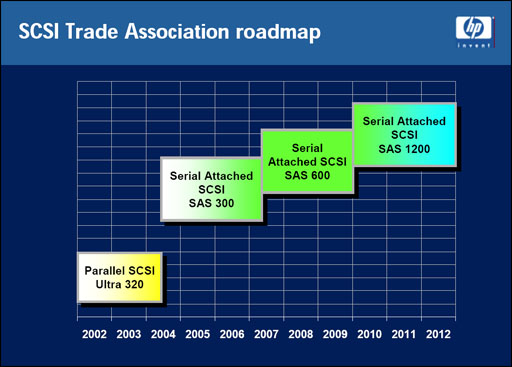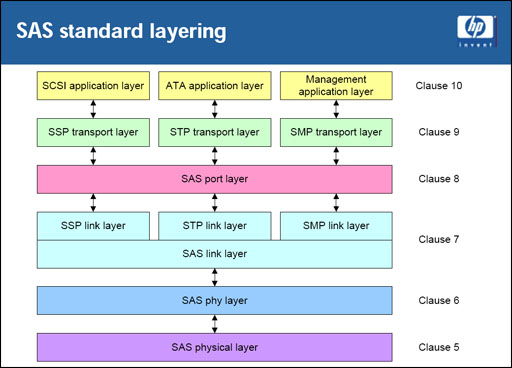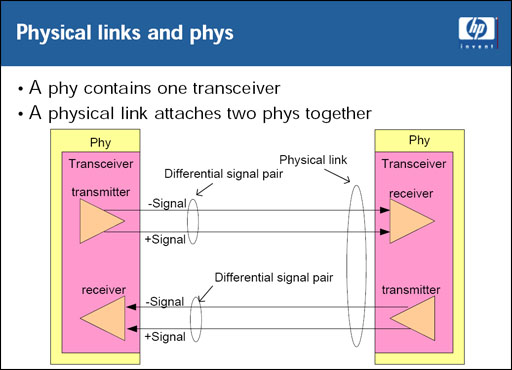Promise VTrak J300s
by Jason Clark & Dave Muysson on February 2, 2007 8:00 AM EST- Posted in
- IT Computing
Basic SAS Architecture
The main advantages for SAS over SCSI are that it has a point to point architecture and much smaller cabling requirements. Modern parallel SCSI operates on a shared bus (every device shared the total bus bandwidth and was limited by the slowest device), ranging in bandwidth from 160MB/s to 320MB/s. SAS is capable of 3Gbit with 6Gbit in the works, and with the 8/10 data encoding that works out to 300MB/s and 600MB/s. More importantly, that bandwidth is per device, so it is unlikely in the near term that any single device will be able to saturate the available bandwidth. One other huge advantage that SAS has is its ability to interoperate with SATA devices. Most of the SAS enclosures sold today offer the ability to mix SAS and SATA drives, which allows for endless possibilities in architecting a storage infrastructure. Below is the SAS roadmap from the SCSI Trade Association.

As you can see from the diagram below, the SAS standard layering is made up of 6 distinct layers, each with a specific purpose.

The lowest layer of SAS is the physical link layer, which consists of cables, connections, and the electrical characteristics for the SAS transmitter and receiver in the SAS phy. A SAS phy is a combination of the physical layer, phy layer and the link layer functions. A phy at the target and the initiator make up a physical connection. When multiple phy's are grouped together, it can be referred to as a "Wide Port". Once each pair of phys is connected together to form a physical link, the aggregate bandwidth of the port will incrementally increase.

The link layer is the third lowest layer and it interfaces with the SAS phy layer and the SAS Port layer. Its main purpose is to control the SAS phy layer to manage connections with other SAS devices. Next in the stack is the Port layer; it receives requests from the transport layer, interprets the requests, selects link layers (which in turn select phys that are used to establish connections), and forwards the requests to the selected link layer for transmission.
The second highest layer is the transport layer. This layer receives requests from the application layer, constructs frames and sends them to the port layer, validates the frames and notifies the application layer. Last but certainly not least is the application layer, whose main purpose is to create tasks for the transport layer to process.
The main advantages for SAS over SCSI are that it has a point to point architecture and much smaller cabling requirements. Modern parallel SCSI operates on a shared bus (every device shared the total bus bandwidth and was limited by the slowest device), ranging in bandwidth from 160MB/s to 320MB/s. SAS is capable of 3Gbit with 6Gbit in the works, and with the 8/10 data encoding that works out to 300MB/s and 600MB/s. More importantly, that bandwidth is per device, so it is unlikely in the near term that any single device will be able to saturate the available bandwidth. One other huge advantage that SAS has is its ability to interoperate with SATA devices. Most of the SAS enclosures sold today offer the ability to mix SAS and SATA drives, which allows for endless possibilities in architecting a storage infrastructure. Below is the SAS roadmap from the SCSI Trade Association.

As you can see from the diagram below, the SAS standard layering is made up of 6 distinct layers, each with a specific purpose.

The lowest layer of SAS is the physical link layer, which consists of cables, connections, and the electrical characteristics for the SAS transmitter and receiver in the SAS phy. A SAS phy is a combination of the physical layer, phy layer and the link layer functions. A phy at the target and the initiator make up a physical connection. When multiple phy's are grouped together, it can be referred to as a "Wide Port". Once each pair of phys is connected together to form a physical link, the aggregate bandwidth of the port will incrementally increase.

The link layer is the third lowest layer and it interfaces with the SAS phy layer and the SAS Port layer. Its main purpose is to control the SAS phy layer to manage connections with other SAS devices. Next in the stack is the Port layer; it receives requests from the transport layer, interprets the requests, selects link layers (which in turn select phys that are used to establish connections), and forwards the requests to the selected link layer for transmission.
The second highest layer is the transport layer. This layer receives requests from the application layer, constructs frames and sends them to the port layer, validates the frames and notifies the application layer. Last but certainly not least is the application layer, whose main purpose is to create tasks for the transport layer to process.










31 Comments
View All Comments
shady28 - Sunday, February 4, 2007 - link
Here are some graphs the author should look at :http://www.storagereview.com/articles/200609/ST330...">http://www.storagereview.com/articles/200609/ST330...
http://www.storagereview.com/articles/200601/250_i...">http://www.storagereview.com/articles/200601/250_i...